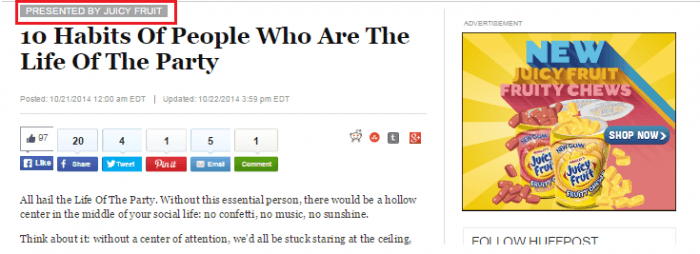Every year, a crop of newfangled words and phrases is added to our dictionaries—and technology is driving a lot of the most recent additions. For example, hashtag, selfie, and big data were all added to the Merriam-Webster’s Collegiate Dictionary in 2014, and more novel terms are being generated all the time. It can be difficult to keep up, especially in the fast-paced world of digital marketing. That’s why we continually update our digital marketing glossary, in the hopes that our readers will find it to be a useful guide in the rapidly changing landscape.
Recently, we added five new terms to the glossary, and each one tells a different story about the latest evolution of online marketing. Take a look, and find out why these phrases made the cut.
Geographical Targeting
According to our glossary, this strategy, also called geotargeting, is used to determine where visitors are located on the map in order to deliver relevant content to them. Of course, there’s a number of different ways to make that happen:
- Search: Most search engines provide location targeting so your paid search ads appear only in the geographic locations that you choose, such as in certain countries, areas within a country, a radius around a location, or location groups.
- Online: By identifying a web visitor’s location, you can serve up content specific to that location. This includes matching languages, currency, visuals, and many other elements.
- Mobile: Using smartphone users’ GPS, marketers can deliver ads that are applicable to where they are. For example, if a blizzard hits a certain area, you can send a message to your audience that snow shovels are on sale in a nearby store. With geofencing (which creates a radius around a certain area), you can target customers with a tailored message when the GPS indicates they’ve entered the area. You can even be notified that they’ve arrived. For example, if VIP customers walk into your store, your sales associates could get an alert – as well as buying history – so they would be able to tailor their customer service to the VIP.
- Email: Personalizing an email with location-based details is a great way to increase engagement. For example, you can send prospects an alert about a local event that’s relevant to their interests, like a seminar or a networking event.
- Social media: Advertisers on Twitter can use geotargeting to deliver promoted tweets tailored to regional audiences, and Facebook marketers can use location criteria for promoted posts as well as Facebook ads. Facebook also recently announced the launch of hyper-local advertising, which targets ads within a specific distance of a specific retail location.
Of course, like any strategy, it’s important to test geographical targeting in order to make sure it’s getting the results you want. But in general, people prefer content that’s relevant to where they are – and what they want.
Native Advertising
According to our glossary, native advertising is a type of promotion where the content matches the form of the platform on which it appears. For example, an article appearing on a news site that has been sponsored by a corporation would be considered native advertising. This sponsored content can be highly effective – and also somewhat problematic.
According to research from the Interactive Advertising Bureau (IAB) and Edelman Berland, when asked to look at real-world mockups of news pages, 41% of general audiences had trouble recognizing that the material was advertising. Brands that attempt to fool people into believing they’re reading a real news story can find themselves with angry people on their hands – as well as lost business.

In December 2013, BIA/Kelsey projected that native would rise from 38.8% in 2014 to 42.4% in 2017. So clearly, branded content isn’t going away. Check out a few examples of companies that are getting it right (and a few that are doing it wrong).
Newsjacking
Here’s another potentially problematic way to get your message across. In our glossary, newsjacking is defined as taking advantage of a breaking story by piggybacking onto it in the hopes of gaining attention of the media or the general public. For example, during a power outage, a flashlight company might add a hashtag about a local blackout to promote their product. But many brands have made a mess of it, and it’s easy to see how a hot news story can develop into a PR nightmare.
For example, clothing brands like American Apparel, Gap, and Urban Outfitters all tried to create buzz after Hurricane Sandy hit by taking to channels like Facebook and Twitter with hurricane-related promotions. Urban Outfitters tweeted, “This storm blows (but free shipping doesn’t)!” That tweet led to plenty of backlash (and also plenty of buzz). Companies should tread carefully when trying to jack the news.
Social Selling
According to Forbes, social selling is one of the hottest buzzwords in today’s technology market. Our definition is pretty simple: it’s all about developing relationships with prospects through social media – along with many other channels – in order to engage them. At least, it sounds simple. Developing a social selling strategy isn’t easy, but it does get significant results. Check out this blog post from a member of the Act-On sales team to find out how to create a step-by-step approach to finding, engaging, and converting leads through social channels.
Webinar
 This one isn’t new, but we left it out of earlier editions. As defined by the glossary, a webinar is a seminar or informational meeting conducted over the Internet, also called a webcast. Of course, webcasts, web conferencing, online presentations, and web-based seminars have been around for years. But what’s interesting about webinars is not what we call them or how we define them – it’s how many of them are being produced these days, and how effective they can be. According the MarketingSherpa, 92% of B2B marketers considered webinars and webcasts to be very or somewhat effective at achieving their marketing goals.
This one isn’t new, but we left it out of earlier editions. As defined by the glossary, a webinar is a seminar or informational meeting conducted over the Internet, also called a webcast. Of course, webcasts, web conferencing, online presentations, and web-based seminars have been around for years. But what’s interesting about webinars is not what we call them or how we define them – it’s how many of them are being produced these days, and how effective they can be. According the MarketingSherpa, 92% of B2B marketers considered webinars and webcasts to be very or somewhat effective at achieving their marketing goals.
It makes sense. People who sign up and show up are motivated to solve a problem or fill a need, and it’s likely that they already trust you to help them. Webinars have a lot in common with real-world events in that they can deliver a similar quality of leads, but at much lower cost per lead. Learn more about putting on successful online and in-person events in this white paper.
Check out the digital marketing glossary to learn more terms, and be sure to let us know if we’ve missed any. Because one thing is for sure… we’ll probably be updating it soon to keep up with the constantly changing developments in the world of digital marketing.
